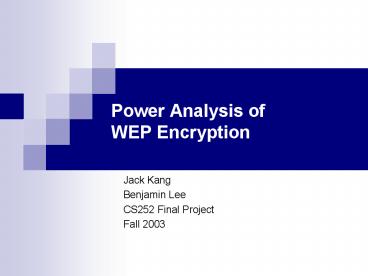Power Analysis of WEP Encryption - PowerPoint PPT Presentation
1 / 24
Title:
Power Analysis of WEP Encryption
Description:
... Microprocessor In-order issue No branch prediction Minimal number of functional units Integer ALU Floating Point ALU Integer Multiplier/Divider Floating Point ... – PowerPoint PPT presentation
Number of Views:102
Avg rating:3.0/5.0
Title: Power Analysis of WEP Encryption
1
Power Analysis of WEP Encryption
- Jack Kang
- Benjamin Lee
- CS252 Final Project
- Fall 2003
2
Outline
- Background and Motivation
- Objective
- Theory
- Experimental Methodology
- Experimental Results
- Conclusions
- Future Work Directions
- Questions
3
Background and Motivation (1/4)
- The Digital Divide
- Gap between the digitally empowered and digitally
poor, between developing and developed nations - Can information and communication technologies
(ICT) close the gap? - There are social AND economic reasons to solve
this problem
4
Background and Motivation (2/4)
- Problems
- More talk than action
- Financial sustainability
- Coordination of activities
- Scope
- E-governance
5
Background and Motivation (3/4)
- Bottom of The Pyramid (BOP)
- Prahad argues that it is profitable to serve the
poor - Multinational Corporations have financial
incentive to step in
Prahalad, C.K. and Hammon, Allen, Serving the
World's Poor, Profitably, Harvard Business
Review, 9/2002.
6
Background and Motivation (4/4)
- So what about the technical problems?
- Low-cost
- Low-power
- Intermittent Connectivity
- User Interfaces for populations with multiple
languages and low levels of literacy - Shared accesses as a possibly dominant use mode
- Limited skilled workforce for maintenance
7
Objective
- Evaluate high-level software optimizations and
low-level hardware configurations for reducing
power dissipation applied to WEP encryption - Provide a framework for further study in wireless
communication infrastructure for developing
regions
8
Theory Loop Unrolling
- A compiler technique that extends the size of
loop bodies by replicating the body n times - The loop exit condition is then adjusted
accordingly - Why is power saved?
- More efficient front end less branches means
the fetch unit is able to fetch large blocks
without being interrupted by control decisions - Less branches in the code means reduced power
dissipation of the branch prediction hardware
9
Theory Cache Optimizations
- Choices in associativity and block sizes will
affect the miss rate of the cache. - Power can be saved if we can reduce the miss
rate. - No need to go off chip
- Better performance means we may be able to lower
the clock frequency (and thus voltage levels) and
still meet minimum performance needs
10
Experimental Methodology
- Software WEP encryption
- Software is cheaper (low-cost)
- Easier to upgrade (limited maintenance)
- SimpleScalar
- Simulates hardware and software configurations
- Wattch
- Provides power estimation
11
Wired Equivalent Privacy (1/3)
- Overview
- 802.11 wireless standard
- Provides wireless network with security
equivalent to wired network - Confidentiality
- Access Control
- Data Integrity
12
Wired Equivalent Privacy (2/3)
- Encryption
Hirani, Sohail A. Energy Consumption of
Encryption Schemes in Wireless Devices. Masters
Thesis. University of Pittsburgh, April 2003.
13
Wired Equivalent Privacy (3/3)
- Decryption
Hirani, Sohail A. Energy Consumption of
Encryption Schemes in Wireless Devices. Masters
Thesis. University of Pittsburgh, April 2003.
14
SimpleScalar (1/2)
- Baseline Simulation - Microprocessor
- In-order issue
- No branch prediction
- Minimal number of functional units
- Integer ALU
- Floating Point ALU
- Integer Multiplier/Divider
- Floating Point Multiplier/Divider
15
SimpleScalar (2/2)
- Baseline Simulation Memory
- L1 Instruction Cache
- 16-KB cache
- 32-byte blocks
- Full associativity
- L1 Data Cache
- 16-KB cache
- 32-byte blocks
- 4-way associativity
- Unified L2 Cache
- 18-KB cache
- 32-byte blocks
- 4-way associativity
16
Wattch (1/2)
- Overview
- Framework for analyzing and optimizing
microprocessor power dissipation at the
architectural level - Wattch v1.02
- SimpleScalar Interface
- Simulated PISA instruction set
- Built on Pentium 4/x86 platform
17
Wattch (2/2)
- Conditional Clocking Styles
- NCC No conditional clocking
- CC1 Simple conditional clocking
- Zero power dissipation with zero accesses
- CC2 Aggressive conditional clocking (ideal)
- Linear power dissipation with fractional accesses
- CC3 Aggressive conditional clocking
(non-ideal) - 15 power dissipation with zero accesses
18
Experimental Results (1/3)
19
Cache Associativity (2/3)
20
Cache Associativity (3/3)
21
Conclusions
- Significant power savings from software and
hardware optimizations - Loop Unrolling
- Max 17 reduction
- Median 15.9 reduction
- Mean 15.9 reduction
- Cache Associativity
- Max 12.5 reduction
- Median 4 reduction
- Mean 5 reduction
22
Future Work Directions
- Study combined effects of optimizations
- Apply these optimizations for new microprocessor
configurations - Apply these optimizations to a larger test suite
23
References
- David Brooks, Vivek Tiwari, and Margaret
Martonosi, Wattch A Framework for
Architectural-Level Power Analysis and
Optimizations, 27th International Symposium on
Computer Architecture (ISCA), June 2000. - Doug Burger and Todd M. Austin, The SimpleScalar
Tool set, Version 2.0, Computer Architecture
News, pages 13-25, June 1997. - Sohail Hirani, Energy Consumption of Encryption
Schemes in Wireless Devices, Masters
Dissertation, University of Pittsburgh, 2003. - Kenneth Keniston, Grassroots ICT projects in
India Some Preliminary Hypotheses, ASCI Journal
of Management 31(12), 2002. - C.K. Prahalad and Allen Hammon, Serving the
World's Poor, Profitably, Harvard Business
Review, September 2002. - C.K. Prahalad and Stuart L. Hart, The Fortune at
the Bottom of the Pyramid, strategybusiness,
issue 26, 2002. - SimpleScalar toolset. http//www.simplescalar.com
- Wattch toolset. http//www.ee.princeton.edu/dbroo
ks/wattch-form.html
24
Questions
- Any Questions?




























![[Latest Update] CompTIA N10-008 Actual Exam Practice Questions Shared Online PowerPoint PPT Presentation](https://s3.amazonaws.com/images.powershow.com/10140974.th0.jpg?_=20240927019)


